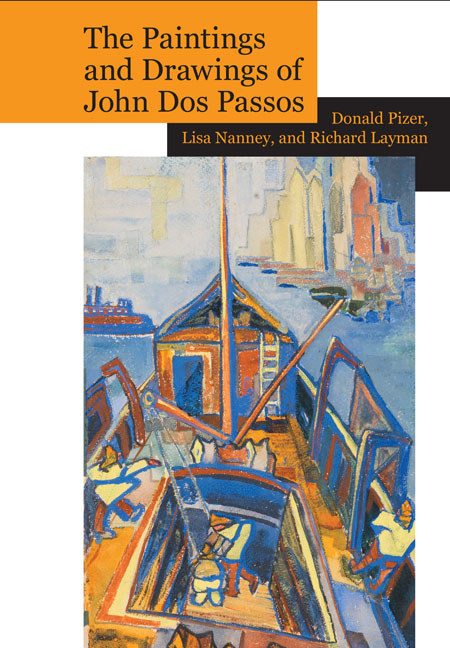Book contents
- Frontmatter
- Contents
- Preface
- Acknowledgments
- The Paintings and Drawings of John Dos Passos: A Collection and Study
- Introduction
- Paintings and Drawings Included in this Volume: A Descriptive List
- Preface to Section 1: Early Work 1918–20
- Preface to Section 2: The Middle East and Morocco 1921–22, 1926
- Preface to Section 3: Paris 1921–25
- Preface to Section 4: New York 1920–24
- Preface to Section 5: New York: Nudes 1920–23
- Preface to Section 6: Theater Designs 1925–28
- Preface to Section 7: Mexico 1926–32
- Preface to Section 8: Later Work 1930–70
- Preface to Section 9: Portraits
- Preface to Section 10: Sea Fronts and Harbors
- Preface to Section 11: Still Lifes
- Preface to Section 12: Studies in Motion
- Preface to Section 13: Abstractions and Other Experimental Modes
- Words and Images: The Visual Art of John Dos Passos
- The Artwork of John Dos Passos
- Notes
- Works Cited
- Index
- Plate section
Preface to Section 6: Theater Designs 1925–28
from The Paintings and Drawings of John Dos Passos: A Collection and Study
- Frontmatter
- Contents
- Preface
- Acknowledgments
- The Paintings and Drawings of John Dos Passos: A Collection and Study
- Introduction
- Paintings and Drawings Included in this Volume: A Descriptive List
- Preface to Section 1: Early Work 1918–20
- Preface to Section 2: The Middle East and Morocco 1921–22, 1926
- Preface to Section 3: Paris 1921–25
- Preface to Section 4: New York 1920–24
- Preface to Section 5: New York: Nudes 1920–23
- Preface to Section 6: Theater Designs 1925–28
- Preface to Section 7: Mexico 1926–32
- Preface to Section 8: Later Work 1930–70
- Preface to Section 9: Portraits
- Preface to Section 10: Sea Fronts and Harbors
- Preface to Section 11: Still Lifes
- Preface to Section 12: Studies in Motion
- Preface to Section 13: Abstractions and Other Experimental Modes
- Words and Images: The Visual Art of John Dos Passos
- The Artwork of John Dos Passos
- Notes
- Works Cited
- Index
- Plate section
Summary
During his relatively brief but intense engagement with play production from 1925 to 1928, Dos Passos prepared the set designs for his own play, The Garbage Man, as well as for Paul Sifton's The Belt, a drama involving automobile factory workers. He produced in these designs a remarkable body of work that reveal both his full control of the style he had developed over the previous half-decade and the effect upon this style of the Expressionistic-Pop Culture artistic ethos of The New Playwrights group.
The stage direction for Scene 1, Part One, of The Garbage Man reads: “The curtains part showing a painted drop of factories, endless perspectives of gutted windows, craning chimneys, in the blue light of a winter dawn.” Dos Passos's visual conception of this industrial landscape in figure 30, Factory, is to cast it as a composition of horizontal, diagonal, and vertical strands. Aside from its multiple chimneys, the painting contains little that is distinctive to a factory; its impact arises rather from the painter's realization that a mass of ill-defined, intertwined, angular, and dimly threatening industrial images would create the effect he wished. A similar kind of exuberant freedom within a prescribed setting characterizes the backdrop for Scene 4, Part One (fig. 32, Smash-up). Here the stage direction reads: “The drop shows tracks and telegraph poles.… On one side the arm of a wrecking crane. Everything is toppling, confused, jagged” (50). In this instance, Dos Passos composed the drop around the recurring image of the railway track. Tracks occupy every portion of the painting, from the extended sections on the left bottom and left top to much of the debris pile on the right to fragments on the upper right and left, with almost all of these running toward a stalled passenger car at the center of the drop.
The backdrop for Scene 2, Part Two (fig. 34, City Towers), however, while effective in its own way, also illustrates the thematic literalism inherent in the Expressionistic mode. The stage direction reads: “A back yard in downtown New York. In the distance, across building lots and through a bluish curtain of smoke and dust there is a pearly shimmer of skyscrapers rising near the middle to the Woolworth tower.
- Type
- Chapter
- Information
- Publisher: Liverpool University PressPrint publication year: 2016



